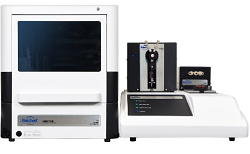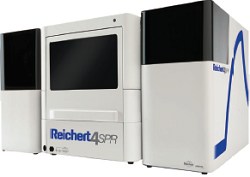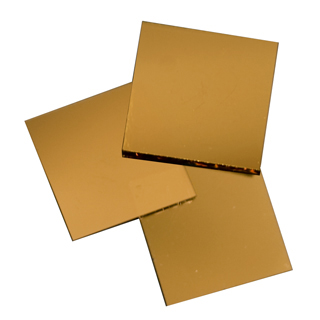

In the biochemical and biological systems when measuring the interactions between the different molecules, the techniques based on labeling the molecules are increasingly pushed in the background. The method based on surface plasmon resonance suitable for analysing the interactions occurring near the surfaces occupies a prominent place among the label-free analyses. With the help of this method not only the end point can be displayed but the occurrence of the entire process can be monitored. The suitably selected molecule from the binding pair of the molecules interacting during the measurements is fixed to a 50 nm thick gold surface, while its interacting partner is flown above it. The measurement takes place on a scratch-resistant sapphire prism whose temperature is adjustable. The reactions, occurring above the gold surface illuminated from the other side, influence the intensity of the light rays reflected at different angles, which can indicate the occurence strength of the interactions.The evaluation of the results and the kinetic calculations can be carried out with the TraceDrawer program, which calculates the speed constants characteristic of the interactions, performs the measurement data processing of the Reichert SPR software and prepares a report with the graphic representation of the data. This method can be used excellently for examining antibody-antigen, protein-protein, receptor-ligand, protein-DNA, protein-virus, protein-cell interactions.
The following are parts of the Reichert’s modular dual channel, surface plasmon resonance (SPR) systems:
- SR7500DC instrument, which contains the optical and electronic
 components necessary for the measurement.
components necessary for the measurement. - SR8500 syringe pump for providing continuous sampling and flow. In the case of small amount of sample, it is possible to move the liquid back and forth in the flow cell with the pump.
- SR8600 computer-controlled diverter valve. It makes possible the selection of the flow channel from the serial-connected ones: the liquid will flow through one or both channels.
- SR8300 computer-controlled semi-automatic injector with manually refillable replaceable sample loop.
- SR8100 autosampler with sample cooling, with biocompatible PEEK tubing, injection options from 96 and 384-place microplates, from 1.5 and 10 ml vials.
- Control software for the programming of the association, equilibrium and dissociation steps.
Specifications:
- light source: light from 780nm LED arrays fed into an integrating sphere assuring so a high intensity homogeneous spatial distribution
- measuring cell: dual channel flow cell, illuminated surface: 4.5 mm2
- temperature range: from 4°C to 70°C (max 10°C below the ambient temperature)
- detection: two extreme sensitive 1024 pixel array photodiode
- refractive index resolution: <1×10-7 RIU
- refractive index range: 1.33 – 1.40
- concentration range: 1 mM – 1 pM
- minimum detectable molecule size: 100 Dalton
- liquid path: easy to handle and to replace HPLC-type tubing
- sample injection:
- 2 pcs 96 well microplate
- 2 pcs 384 well microplate
- 2 db 48 positions HPLC (1,5ml) vial holder
- amount of sample: depends from the installed loop 1 μl – 4500 μl

The 4SPR system is the youngest one among the Reichert surface plasmon resonance (SPR) instruments. The advanced four-channel SPR system provides triple the efficiency of the 2-channel instrument with the same precision and flexibility as the SR7500DC instrument. The system includes the optical detector, the 4-channel thermostatable flow cell, the liquid flow pump, the degasser and the autosampler with sample cooling. The system control is provided by the Reichert4SPR software, which allows the simple but effective planning and completion of the exeperiments in a modern user environment.
Specifications:
- light source: light from 780nm LED arrays fed into an integrating sphere assuring so a high intensity homogeneous spatial distribution
- measuring cell: four channel flow cell
- temperature range: from 4°C to 70°C (max 10°C below the ambient temperature)
- detection: 2D CCD detector
- refractive index resolution: <1×10-7 RIU
- refractive index range: 1.33 – 1.40
- concentration range: 1 mM – 1 pM
- minimum detectable molecule size: <100 Dalton
- liquid path: easy to handle and to replace HPLC-type tubing
- sample injection:
- 2 pcs 96 well microplate
- 2 pcs 384 well microplate
- 2 db 48 positions HPLC (1.5 ml) vial holder
- amount of sample: depends from the installed loop 1 μl – 4500 μl
- E-SPR flow cell for simultaneous electrochemical and SPR measurements
- Quartz window flow cell for light-induced immobilization techniques, photopolymerization and optical observations
- gold-plated SPR sensor chip

- SPR sensor chip with a surface of 10% mSAM (10% alkane thiol (PEG)6-COOH, 90% alkane thiol (PEG)3-OH)
- SPR sensor chip with a surface of dithiol SAM/COOH
- SPR sensor chip with a surface of Ni-NTA (nickel-nitrilotriacetic acid) for poly-His labelledproteins
- SPR sensor chip with a surface of hydrophobic alkyl for hydrophobic molecules e.g. lipids
- SPR sensor chip with a surface of streptavidin for biotin-labeled molecules
- SPR sensor chip with a surface of carboxymethyl dextran 200 nm thick 3-D hydrogel
- SPR sensor chip with a surface of linear polycarboxylate 150 nm 3-D hydrogel

